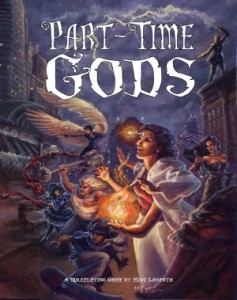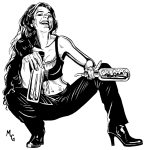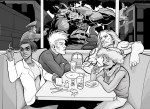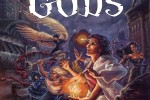Part-Time Gods
Part-Time Gods is a complete game powered by the Dynamic Gaming System-Lite and published by Third Eye Games.
By Eloy Lasanta

Welcome to the eighteenth Designer’s Diary, a regular column where designers are given the opportunity to take readers on an in-depth ride through the design and development process of their system, setting, or product. If you’d like to share your product in the Designer’s Diary column, send a message to aaron@roleplayerschronicle.com.
Designer’s Description
Oh, Part-Time Gods. It’s a game where players take the role of a regular, everyday person that is – swish-bang-boom! – imbued with the power of a god. They get strength, magic, sometimes a few worshippers or powerful relics, but in the end they are still a person. The characters still have their friends, family, jobs and social relationships to keep them grounded as a human being, even if they just so happen to have monsters, pucks and other gods after them to steal their power. So, while the character is at their little sister’s b-day party, they may have to leave to defend their territory from a Minotaur or a Giant. The game uses the new DGS-Lite (Dynamic Gaming System-Lite), a less crunchy version of the same system that runs my two previous games, Apocalypse Prevention, Inc. and Wu Xing: The Ninja Crusade. It’s flexible enough to handle the player choosing whatever they want their character to be the god/goddess of, kind of in a mad lib sort of way. The game is very rewarding to a creative group.
Purpose
Few know this, but Part-Time Gods was supposed to be my second gameline, but was beat out by Wu Xing: The Ninja Crusade. Still, even though there were a few other gods games out there, none of them scratch the particular itch that I wanted. Most games out there are all about being actual divine beings, gods that look at humans as only tools and worshippers, or you have to be the child of a god or a chosen of a god. In most cases, you are told what to do with little to no actual consequences for your actions. There’re exceptions to this, of course, but from what I saw of the responses to the big games out there, the fans weren’t satisfied with the status quo. It was finally time for Part-Time Gods to be released and is a big reason why it is doing so well, even after only being out for about 2 months.

Influences
I came up with the idea for Part-Time Gods when I was watching the TV show “Dead Like Me”. For those unfamiliar with the show, it follows a girl that dies and then finds out that she’s a Grim Reaper. She ends up with a group of other Grim Reapers that show her the ropes, the most important being that she’s still just a regular person – now with a lot of new dangers and responsibilities. I went on to read (and reread) some of my favorite Neil Gaiman books, like American Gods and Neverwhere, and then drew a lot of influence from my extensive comic book fandom. The idea behind Part-Time Gods was to create the kind of tension and drama that one can get when you have to balance your mortal life with a new divine existence.
Mechanically, Part-Time Gods took from the classic DGS first and foremost. The change to the DGS-Lite system was a decision made to better fit the game’s theme and a lot of people seem to be enjoying it. Again, the whole system uses a single d20 against target numbers with lots of options to get bonuses based on your descriptions or sacrifices your character can make.
Research
While most of Part-Time Gods revolved around me getting my own ideas across, even coming up with a crazy alternate history to explain why gods work differently in my game, there was still a lot of research involved. I looked into several of the world mythologies, sorting them out and figuring out which ones I wanted to pull from and use in my game. A lot of this shows in the Antagonist chapter that has over 40 different enemies to fight against, from skin walkers and seers to djinn and Rakshasa. The setting itself is simply modern day, allowing players to even be the gods of their own hometowns, which I thought was important for removing the need for research into too much mythology.

Art Direction
Art direction for Part-Time Gods has to be very specific. The game isn’t about world-destroying gods of old with power to crush the sun. It is about normal people thrust into a world that they may not actually know what the hell they are doing. To show off this angle, we could have too many pieces of art in superhero poses or with masses of worshippers. There were instead pictures of characters doing whatever they’d normally do, but just a little better. There’re still lots of pieces of the characters doing absolutely amazing and awesome stuff, but its obvious that they are regular people doing these things.
This was definitely something that we tried to get across with our cover as well. Part-Time Gods had the possibility of being compared to a supers game, so it was imperative that the cover not give this impression right off the bat. While you might be able to play a supers game with Part-Time Gods, it wasn’t really designed to do that and you’re better off checking out an actual supers RPG for that kind of experience. We had a lot of very talented artists on this book as well, so let me take a moment to thank them all for their hard work.

Comparison
So, as this is my third gameline, my tri-fecta if you will, we should probably talk about how Part-Time Gods compares to my two previous games. Changes to the DGS were important to getting the feeling and play experience across for this game. While Apocalypse Prevention, Inc. and Wu Xing: The Ninja Crusade both focused on strategic combat, Part-Time Gods was much more about freeform magic and making it easy to pull off effects without too much effort. The combat tracker was removed from the DGS, thus making it the DGS-Lite, but there’s little else that is very different between the games besides a little bit of math. In the same breath, I’m so happy that I’ve had the opportunity to release three completely different games to the RPG market, each with its own feel and its own fanbase (which is really nice).
Part-Time Gods has been out for about 2 months and has been compared a lot to Scion, from White Wolf. More than a few gamers out there have called it “Street Scion”. I feel our game is definitely more flexible in its execution, but I had many sessions of fun with Scion, so I certainly wouldn’t want to disparage it at all. It’s also compared to Nobilis, due to its fill-in-the-blank approach to divinity, and appears to be seen as an alternative for people who like dice instead of resource management. I haven’t actually played or read Nobilis, so I can’t say how similar it really is to Part-Time Gods.
Development Process
I had a very clear idea of what I wanted out of Part-Time Gods from the get go. It took years and at least 7 incarnations of the magic rules to make it the game that it is now. I just kept reinventing what it was to be while in development, which is why it took so long to release. The two aspects of setting and system had to mesh together seamlessly and it’s the job of the designer (me) to get that across. After working a bit on the setting, I’d switch to the system to see what I could do to reflect that bit and then maybe a little more. Then I’d go back to the setting and see how that new rule I came up with could make the setting even cooler.
A good example of this is the rules for influencing your territory. There were a few different versions of that, first belonging only to the Drifting Kingdoms Theology, and then spreading to be a tool for the rest of the gods too. When it was all said and done, it created a sort of sub-system of competing divine influences in the same territory. So, if I’m the god of fire and you’re the god of death, there’s going to be a lot of deaths by arson in our territory.
In the end, I am happy to say that Part-Time Gods is a completely unique game that I am proud to have released.




